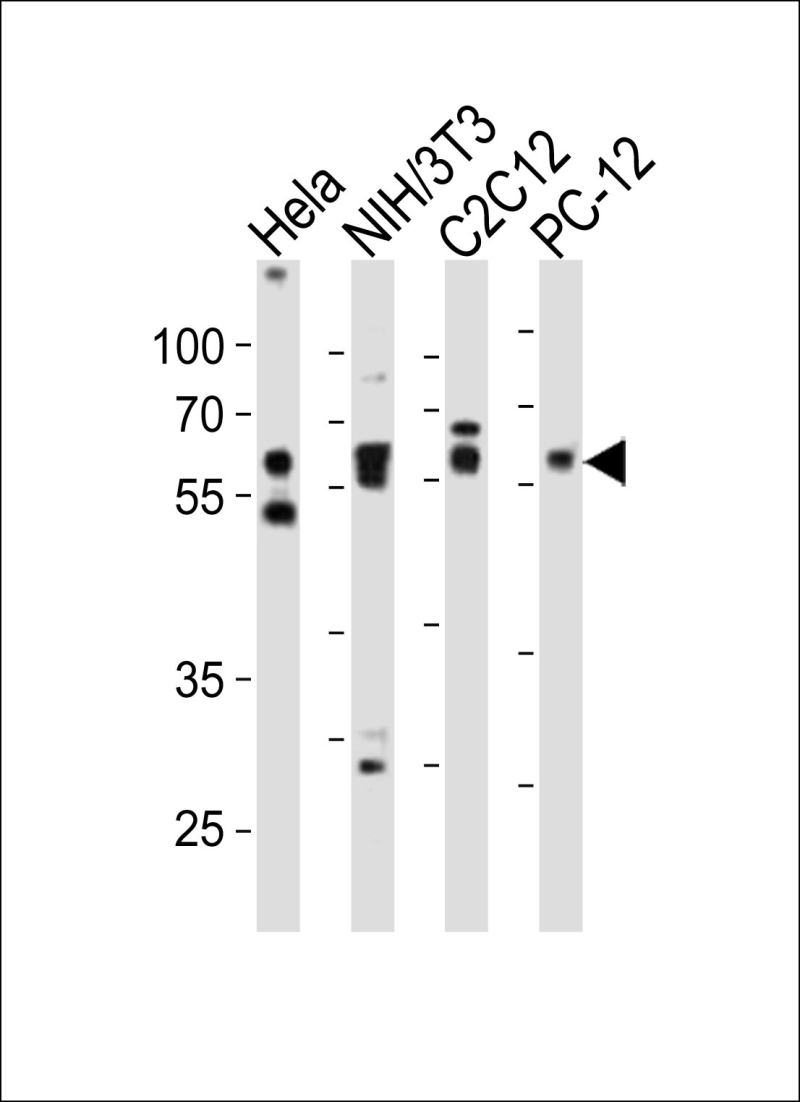
| WB | 1/1000 | Human,Mouse,Rat |
| IF | 咨询技术 | Human,Mouse,Rat |
| IHC | 咨询技术 | Human,Mouse,Rat |
| ICC | 技术咨询 | Human,Mouse,Rat |
| FCM | 咨询技术 | Human,Mouse,Rat |
| Elisa | 咨询技术 | Human,Mouse,Rat |
| Aliases | Mothers against decapentaplegic homolog 2, MAD homolog 2, Mothers against DPP homolog 2, Mad-related protein 2, mMad2, SMAD family member 2, SMAD 2, Smad2, Smad2, Madh2, Madr2 |
| Entrez GeneID | 17126 |
| WB Predicted band size | 52.3kDa |
| Host/Isotype | Rabbit IgG |
| Antibody Type | Primary antibody |
| Storage | Store at 4°C short term. Aliquot and store at -20°C long term. Avoid freeze/thaw cycles. |
| Species Reactivity | Human, Mouse, Rat |
| Immunogen | This mouse Smad2 antibody is generated from a rabbit immunized with a KLH conjugated synthetic peptide between 198-232 amino acids from the Central region of mouse Smad2. |
+ +
以下是关于小鼠(Mouse)Smad2抗体的3篇示例文献(注:以下内容为模拟示例,实际文献需根据具体数据库检索):
---
1. **文献名称**: "Specific detection of phosphorylated Smad2 in mouse embryonic fibroblasts using a monoclonal antibody"
**作者**: Nakao A. et al.
**摘要**: 该研究开发了一种特异性识别小鼠Smad2磷酸化形式(Ser465/467)的单克隆抗体,验证了其在Western Blot和免疫荧光中对TGF-β信号通路的激活检测,并应用于胚胎成纤维细胞模型中的信号转导研究。
2. **文献名称**: "Characterization of Smad2 knockout mice reveals its role in embryonic development"
**作者**: Weinstein M. et al.
**摘要**: 文章通过基因敲除小鼠模型研究Smad2功能,并利用特异性Smad2抗体(货号:AB1234. ABCAM)进行组织免疫组化分析,证实Smad2在胚胎中胚层形成中的关键作用。
3. **文献名称**: "A novel Smad2 antibody for chromatin immunoprecipitation in murine models"
**作者**: Brown K.A. et al.
**摘要**: 该文献报道了一种高亲和力的小鼠Smad2多克隆抗体(Cell Signaling Technology, #5438),可特异性用于染色质免疫沉淀(ChIP)和流式细胞术,揭示了Smad2在肿瘤微环境中的转录调控机制。
---
如需具体文献,建议通过 **PubMed** 或 **Google Scholar** 检索关键词“Mouse Smad2 antibody” + “Western Blot/Immunohistochemistry/ChIP”等实验方法。
The Smad2 antibody is a crucial tool for studying the transforming growth factor-beta (TGF-β) signaling pathway, which regulates diverse cellular processes, including proliferation, differentiation, and apoptosis. Smad2. a receptor-regulated Smad (R-Smad), is phosphorylated by activated TGF-β type I receptors upon ligand binding. This phosphorylation triggers its association with Smad4. forming a complex that translocates to the nucleus to modulate target gene expression. Unlike Smad3. Smad2 lacks a DNA-binding domain and relies on interactions with other transcription factors for DNA binding.
Mouse Smad2 antibodies are specifically designed to detect endogenous Smad2 protein in mouse-derived samples. These antibodies are widely used in techniques such as Western blotting, immunoprecipitation, and immunofluorescence to assess Smad2 expression, phosphorylation status, and subcellular localization. They are essential for investigating TGF-β signaling dynamics in developmental biology, cancer (where Smad2 mutations or dysregulation are implicated), and fibrotic diseases.
Many commercial Smad2 antibodies are raised against conserved epitopes, such as the N-terminal or C-terminal regions, ensuring cross-reactivity with mouse, human, and rat homologs. Validation typically includes knockout cell lines or siRNA-mediated knockdown to confirm specificity. Researchers rely on these antibodies to explore Smad2's role in TGF-β-mediated epithelial-mesenchymal transition (EMT), immune regulation, and its crosstalk with other signaling pathways like Wnt or MAPK. Quality-controlled batches are critical to minimize variability in experimental outcomes.
×